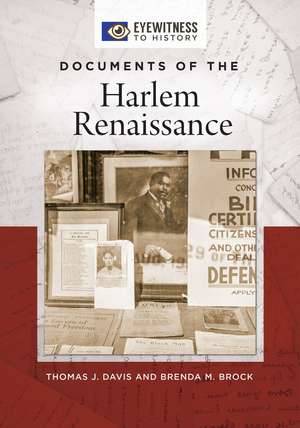Documents of the Harlem Renaissance: Eyewitness to History
Autor Thomas J. Davis, Brenda M. Brocken Limba Engleză Hardback – 12 ian 2021 – vârsta până la 17 ani
Preț: 412.49 lei
Preț vechi: 717.36 lei
-42% Nou
Puncte Express: 619
Preț estimativ în valută:
78.93€ • 82.63$ • 65.31£
78.93€ • 82.63$ • 65.31£
Carte tipărită la comandă
Livrare economică 05-19 aprilie
Preluare comenzi: 021 569.72.76
Specificații
ISBN-13: 9781440855566
ISBN-10: 1440855560
Pagini: 288
Dimensiuni: 178 x 254 mm
Greutate: 0.8 kg
Editura: Bloomsbury Publishing
Colecția ABC-CLIO
Seria Eyewitness to History
Locul publicării:New York, United States
ISBN-10: 1440855560
Pagini: 288
Dimensiuni: 178 x 254 mm
Greutate: 0.8 kg
Editura: Bloomsbury Publishing
Colecția ABC-CLIO
Seria Eyewitness to History
Locul publicării:New York, United States
Caracteristici
Defines the "New Negro" within the context of the Harlem Renaissance, explaining how the identity of the "New Negro" was central to the ideology and cultural expressions of the Harlem Renaissance
Notă biografică
Thomas J. Davis, PhD, JD, is professor emeritus of history at Arizona State University, Tempe.Brenda M. Brock, MA, ABD, is an independent scholar of American and African American literature.
Cuprins
PrefaceEvaluating and Interpreting Primary DocumentsIntroductionChronologyChapter 1 The New Negro Mecca: Harlem1. "Harlem," Alain Locke (1925)2. "The Black City," Eric Walrond (1924)3. "The Making of Harlem," James Weldon Johnson (1925)4. "The City of Refuge," Rudolph Fisher (1925)5. "Harlem's Nightlife," Wallace Thurman (1927)6. "Amateur Night in Harlem: 'That's Why Darkies Were Born,'?" Dorothy West (1938)7. "When Harlem Was in Vogue," Langston Hughes (1940)Chapter 2 The New Negro: A New Time, A New People8. "Lift Every Voice and Sing," James Weldon Johnson (1900)9. "A New Negro for a New Century," Booker T. Washington et al. (1900)10. "The Souls of Black Folk," W. E. B. Du Bois (1903)11. "Possibilities of the Negro: The Advance Guard of the Race," W. E. B. Du Bois (1903)12. "Public Opinion and the Negro," Charles S. Johnson (1923)13. "The New Negro Faces America," Eric Walrond (1923)14. "Enter the New Negro," Alain Locke (1925)15. "Who Is the New Negro, and Why?" J. A. Rogers (1927)Chapter 3 The New Negro at War16. "Plea of the Negro Soldier," Charles F. White (1907)17. "Her Thirteen Black Soldiers," Archibald H. Grimké (1917)18. "Close Ranks," W. E. B. Du Bois (1918)19. "Du Bois, One-Time Radical Leader Deserts and Betrays Cause of His Race," William Monroe Trotter (1918)20. "A Negro Woman to Her Adopted Soldier Boy," Florence Lewis Bentley (1918)21. "The American Negro in the World War," Emmett J. Scott (1919)22. "Returning Soldiers," W. E. B. Du Bois (1919)23. "The Colored Soldier," Langston Hughes (1919)24. "Two Americans," Florence Lewis Bentley (1921)25. "The Black Draftee from Dixie," Carrie Williams Clifford (1922)Chapter 4 The New Negro on the Move26. "Bound for the Promised Land," Chicago Defender (1916)27. "Is Migration a Panacea?" Cleveland Advocate (1920)28. "How Much Is the Migration a Flight from Persecution?" Charles S. Johnson (1923)29. "Cotton Song," Jean Toomer (1923)30. "Northboun'," Ariel Williams (1927)31. "A Summer Tragedy," Arna Bontemps (1933)Chapter 5 The New Negro under Attack32. "The Lynching of Jube Benson," Paul Laurence Dunbar (1904)33. "The South's Ungolden Rule," Charles F. White (1907)34. "Lynching: Our National Crime," Ida B. Wells-Barnett (1909)35. "The Massacre in East St. Louis," NAACP (1917)36. "Chicago and Its Eight Reasons," Walter F. White (1919)37. "The Eruption of Tulsa," Walter F. White (1921)38. "The Lynching," Claude McKay (1922)39. "The Harvest of Race Prejudice," Kelly Miller (1925)40. "Scottsboro," Langston Hughes (1931)Chapter 6 The New Negro Self Vision41. "If We Must Die," W. A. Domingo (1919)42. "If We Must Die," Claude McKay (1919)43. "The Negro Speaks of Rivers," Langston Hughes (1921)44. "I Am a Negro," Marcus Garvey (1923)45. "Vignettes of the Dusk," Eric Walrond (1924)46. "Heritage: What Is Africa to Me?" Countee Cullen (1925)47. "The New Negro College and the Negro Renaissance," Kelly Miller (1926)48. "College," Loren R. Miller (1927)49. "Africa-Our Challenge," Susie Wiseman Yergan (1930)Chapter 7 The New Negro Woman50. "The Colored Woman and Her Part in Race Regeneration," Fannie Barrier Williams (1900)51. "The Heart of a Woman," Georgia Douglas Johnson (1918)52. "This Must Not Be," Carita Owens Collins (1919)53. "A Letter to the Editor," A Southern Colored Woman (1919)54. "On Being Young-A Woman-and Colored," Marita Bonner (1925)55. "Passing," Nella Larsen (1929)Chapter 8 The New Negro Children56. "The True Brownies," W. E. B. Du Bois (1919)57. "Emmy," Jessie Redmon Fauset (1912)58. "The Fairy Good Willa," Minnibelle Jones (1914)59. "A Fairy Story," Carry S. Bond (1919)60. "GYP: A Fairy Story," A. T. Kilpatrick (1921)61. "The Judge," Jessie Redmon Fauset (1921)62. "Drenched in Light," Zora Neale Hurston (1924)63. "To a Dark Girl," Gwendolyn B. Bennett (1927)Chapter 9 The New Negro Aesthetics64. "The Hope of the Negro Drama," Willis Richardson (1919)65. "Negro Art," Mary White Ovington (1921)66. "The Negro Digs Up His Past," Arthur A. Schomburg (1925)67. "Criteria of Negro Art," W. E. B. Du Bois (1926)68. "Art or Propaganda?" Alain Locke (1928)69. "A Brown Aesthete Speaks," Unsigned (1928)70. "The Negro Artist and Modern Art," Romare Bearden (1934)The New Negro Afterward: ConclusionBibliographyIndex
Recenzii
Providing primary sources alongside ample thoughtful information to help with interpretation, this volume will be useful to a wide range of researchers, from high school students to undergraduates to general readers.
An essential starting place for public, high school, and college library reference shelves to undergird coursework in American history, the Black diaspora, and Black feminism, this source deserves every consideration.
Essential. General readers through advanced undergraduates.
An essential starting place for public, high school, and college library reference shelves to undergird coursework in American history, the Black diaspora, and Black feminism, this source deserves every consideration.
Essential. General readers through advanced undergraduates.















